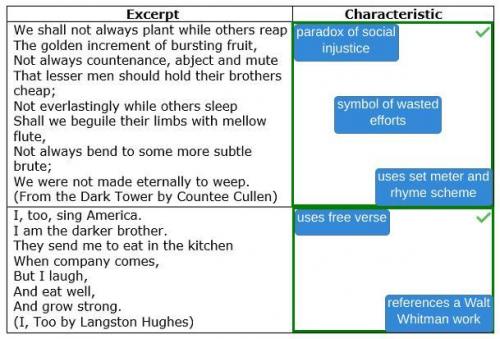Options:
A.) paradox of social injustice
B.) uses set meter and rhyme scheme
C.) symbol of wasted efforts
D.) references a Walt Whitman work
E.) uses free verse characteristic
Answers:
1. A, B, and C refer to:
"We shall not always plant while others reap
the golden increment of bursting fruit,
not always countenance, abject and mute
that lesser men should hold their brothers cheap;
not everlastingly while others sleep
shall we beguile their limbs with mellow flute,
not always bend to some more subtle brute;
we were not made eternally to weep."
(from the dark tower by Countee Cullen)
2. D and E refer to:
"I, too, sing America.
i am the darker brother.
they send me to eat in the kitchen
when company comes,
but i laugh,
and eat well,
and grow strong."
(I, too by Langston Hughes)
Explantion:
A reference to Walt Whitman's "I Hear America Singing" => "I, Too". Langston Hughes' poem adds the African American identity to Whitman's list of ordinary people who constitute and contribute to American collective identity.
Paradox of social injustice => "I, Too". Hughes depicts the social inequality of black people, who are traditionally confined to servitude. He hopes, however, that this will change eventually.
Uses set meter and rhyme scheme => "From the Dark Tower". The poem's rhyme scheme is ABBA.
Symbol of wasted effort => "From the Dark Tower". Black people are the ones who plant, while white people reap.
Stone of anger and resentment => "From the Dark Tower". It depicts black people's anger at being constantly and systematically oppressed.
Uses free verse => "I, Too". Hughes' poem has a conversational tone. The free verse depicts the inner freedom that the speaker feels, and wants to transform into real freedom and equality.
"I, Too" is a poem written by Langston Hughes that demonstrates a yearning for equality through perseverance while disproving the idea that patriotism is limited by race. It was first published in March 1925 in a special issue of the magazine Survey Graphic, titled Harlem: Mecca of the New Negro.



 11
11  11
11  8
8 
 26
26  26
26 
